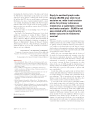

While it is a popular measure, EDSS has been criticized for some of its limitations, such as relying too much on walking. EDSS is also correlated with falls in people with MS. The main measure of disability and severity is the expanded disability status scale (EDSS), with other measures such as the multiple sclerosis functional composite being increasingly used in research. Uhthoff's phenomenon, a worsening of symptoms due to exposure to higher than usual temperatures, and Lhermitte's sign, an electrical sensation that runs down the back when bending the neck, are particularly characteristic of MS. ĭifficulties thinking and emotional problems such as depression or unstable mood are also common. When multiple sclerosis is more advanced, walking difficulties can occur and the risk of falling increases. The specific symptoms are determined by the locations of the lesions within the nervous system, and may include loss of sensitivity or changes in sensation such as tingling, pins and needles or numbness, muscle weakness, blurred vision, very pronounced reflexes, muscle spasms, or difficulty in moving difficulties with coordination and balance ( ataxia) problems with speech or swallowing, visual problems ( nystagmus, optic neuritis or double vision), feeling tired, acute or chronic pain, and bladder and bowel difficulties (such as neurogenic bladder), among others. Ī person with MS can have almost any neurological symptom or sign, with autonomic, visual, motor, and sensory problems being the most common. As of 2009 a number of new treatments and diagnostic methods are under development. The name multiple sclerosis refers to the numerous glial scars (or sclerae – essentially plaques or lesions) that develop on the white matter of the brain and spinal cord. MS was first described in 1868 by French neurologist Jean-Martin Charcot. The disease usually begins between the ages of twenty and fifty and is twice as common in women as in men.

In that year, about 18,900 people died from MS, up from 12,000 in 1990. In 2015, about 2.3 million people were affected globally, with rates varying widely in different regions and among different populations. Multiple sclerosis is the most common immune-mediated disorder affecting the central nervous system. Life expectancy is five to ten years lower than that of the unaffected population. The long-term outcome is difficult to predict good outcomes are more often seen in women, those who develop the disease early in life, those with a relapsing course, and those who initially experienced few attacks. Many people pursue alternative treatments, despite a lack of evidence of benefit. Physical therapy and occupational therapy can help with people's ability to function. Medications used to treat MS, while modestly effective, can have side effects and be poorly tolerated. Treatments attempt to improve function after an attack and prevent new attacks. There is no known cure for multiple sclerosis. MS is usually diagnosed based on the presenting signs and symptoms and the results of supporting medical tests. Proposed causes for this include genetics and environmental factors, such as viral infections. While the cause is unclear, the underlying mechanism is thought to be either destruction by the immune system or failure of the myelin-producing cells. Between attacks, symptoms may disappear completely, although permanent neurological problems often remain, especially as the disease advances. MS takes several forms, with new symptoms either occurring in isolated attacks (relapsing forms) or building up over time (progressive forms). Specific symptoms can include double vision, blindness in one eye, muscle weakness, and trouble with sensation or coordination. This damage disrupts the ability of parts of the nervous system to transmit signals, resulting in a range of signs and symptoms, including physical, mental, and sometimes psychiatric problems. Multiple sclerosis ( MS), also known as encephalomyelitis disseminata, is the most common demyelinating disease, in which the insulating covers of nerve cells in the brain and spinal cord are damaged. Medications, physical therapy, occupational therapy Variable, including almost any neurological symptom or sign, with autonomic, visual, motor, and sensory problems being the most common. Disseminated sclerosis, encephalomyelitis disseminataĬD68-stained tissue shows several macrophages in the area of a demyelinated lesion caused by MS.


 0 kommentar(er)
0 kommentar(er)
